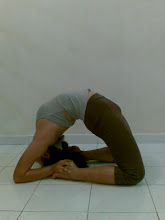MY YOGA CLASSES SCHEDULE
Posted by
CHLOE LEOW
on Saturday, August 29, 2009
/
Comments: (0)
MONDAY 8.30PM-9.30PM (BAYU PERDANA-DANZ FLOOR) intermediate yoga
WENDESDAY 7.30PM-8.30PM (BEHIND KLANG PARADE) new intake
THURSDAY 6.30PM-9.30PM (BEHIND KLANG PARADE) intermediate yoga
SATURDAY 9.30AM-10.30AM (BEHIND KLANG PARADE) new intake
4.30pm-5.15pm (KLANG UTAMA) yogakids
SUNDAY 9.30AM-10.30AM (BEHIND KLANG PARADE) new intake
For more info pls call 012-6868226 CHLOE
vinyasa method
Posted by
CHLOE LEOW
/
Comments: (0)
This style of yoga is characterized by a focus on viṅyāsa, or a dynamic connecting posture, that creates a flow between the more static traditional yoga postures. Vinyasa translates as linking and the system also implies the linking of the movement to the breath. Essentially the breath dictates the movement and the length of time held in the postures. Unlike some Hatha yoga styles, attention is also placed on the journey between the postures not just the postures themselves. The viṅyāsa 'flow' is a variant of Sūrya namaskāra, the Sun Salutation. The whole practice is defined by six specific series of postures, always done in the same order, combined with specific breathing patterns (ujjāyī breathing).
A standard viṅyāsa consists (for example) of the flow from caturaṅga, or plank, to caturaṅga daṇḍāsana, or low plank, to ūrdhva mukha śvānāsana or upward-facing dog, to Adho Mukha Svanasana, or downward-facing dog. The purpose of viṅyāsa is to create heat in the body, which leads to purification of the body through increased circulation and sweating. It also improves flexibility, as well as tendon and hard tissue strength, allowing the student to practice advanced āsanas with reduced risk of injury.
There are six series altogether. Each sequence typically begins with 10 Sun Salutations and the standing poses. This is referred to as the "opening sequence". The student then moves to either the Primary, Intermediate, Advanced A, B, C, or D, depending on his or her skill level, a back-bending sequence, finally closing with a set of inverted postures, referred to as the "finishing sequence". Ashtanga Yoga is traditionally taught in Mysore style (supervised self practice), where each student moves through the practice at his or her own pace and level. In the West, it is more common to find classes devoted to a specific series, and guided by an instructor.
A standard viṅyāsa consists (for example) of the flow from caturaṅga, or plank, to caturaṅga daṇḍāsana, or low plank, to ūrdhva mukha śvānāsana or upward-facing dog, to Adho Mukha Svanasana, or downward-facing dog. The purpose of viṅyāsa is to create heat in the body, which leads to purification of the body through increased circulation and sweating. It also improves flexibility, as well as tendon and hard tissue strength, allowing the student to practice advanced āsanas with reduced risk of injury.
There are six series altogether. Each sequence typically begins with 10 Sun Salutations and the standing poses. This is referred to as the "opening sequence". The student then moves to either the Primary, Intermediate, Advanced A, B, C, or D, depending on his or her skill level, a back-bending sequence, finally closing with a set of inverted postures, referred to as the "finishing sequence". Ashtanga Yoga is traditionally taught in Mysore style (supervised self practice), where each student moves through the practice at his or her own pace and level. In the West, it is more common to find classes devoted to a specific series, and guided by an instructor.
yogi must know- BANDHA
Posted by
CHLOE LEOW
/
Comments: (0)
There are three bandhas which are considered our internal body locks, prescribed in the different postures. The bandha is a sustained contraction of a group of muscles that assists the practitioner not only in retaining a pose but also in moving in and out of it. The Mūla Bandha, or root lock, is performed by tightening the muscles around the pelvic and perineum area. The Uḍḍīyāna Bandha, often described as bringing the navel to the base of the spine, is a contraction of the muscles of the lower abdominal area – this bandha is considered the most important bandha as it supports our breathing and encourages the development of strong core muscles. Jālaṅdhara Bandha, throat lock, is achieved by lowering the chin slightly while raising the sternum and the palate bringing the gaze to the tip of the nose.
chloe CHAT yoga BOX
CHLOE CONTACT
H/P: 012 6868 226
Email: chloeleow_88@hotmail.com
pls do not hesitate to ask, i LOVE to get ur comment
together LOVE yoga, LEARN yoga, PLAY yoga & LIVE yoga
Email: chloeleow_88@hotmail.com
pls do not hesitate to ask, i LOVE to get ur comment
together LOVE yoga, LEARN yoga, PLAY yoga & LIVE yoga
MY YOGA CLASSES SCHEDULE
Mon 8.30pm-9.30pm bayu perdana
Thurs 6.30pm-7.30pm klang parade
Sun 9.30am-10.30am klang parade

